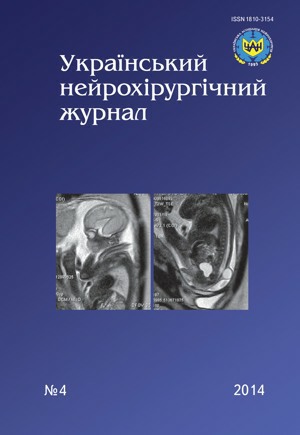The first experience of autologous chondrocytes transplantation after lumbar microdiscectomy
DOI:
https://doi.org/10.25305/unj.46601Keywords:
intervertebral disc, hernia, autologous chondrocytes, transplantationAbstract
The purpose. To develop and provide into clinical practice the hi-tech method of autologous chondrocytes transplantation for treatment of patients with intervertebral discs herniation after lumbar microdiscectomy.
Material and methods. The chondrocytes were isolated from tissues of intervertebral disc hernia, cultivated and preserved, and administrated as percutaneous puncture in the operated intervertebral disc (3 months after microdiscectomy).
We plan to study the influence of transplanted autologous chondrocytes on renewing of intervertebral disc height and function (according to clinical methods, X-ray and MRI).
Results. In 6 patients autologous chondrocytes transplantation was performed. There were no complications or by-effects.
Conclusions. Autotransplantation of chondrocytes in patients after lumbar microdiscectomy is safe and perspective method of surgical treatment at degenerative spine diseases and requires further study.
References
Battié M. Lumbar Disc Degeneration: Epidemiology and Genetics. The Journal of Bone and Joint Surgery (American). 2006;88(suppl_2):3. CrossRef
Shimer A, Chadderdon R, Gilbertson L, Kang J. Gene Therapy Approaches for Intervertebral Disc Degeneration. Spine. 2004;29(23):2770-2778. CrossRef
An H, Thonar E, Masuda K. Biological Repair of Intervertebral Disc. Spine. 2003;28(supplement):S86-S92. CrossRef
Chan D, Song Y, Sham P, Cheung K. Genetics of disc degeneration. European Spine Journal. 2006;15(S3):317-325. CrossRef
Wallach C, Gilbertson L, Kang J. Gene Therapy Applications for Intervertebral Disc Degeneration. Spine. 2003;28(supplement):S93-S98. CrossRef
Roughley P.J. Parameters that influence change in nucleus pulposus composition. Spine. 2004;29:2691–2699.
Yoon S, Patel N. Molecular therapy of the intervertebral disc. European Spine Journal. 2006;15(S3):379-388. CrossRef
Kovac D, Rotim K, Kovac V, Perović D, Kvesić D, Cerina V, Bozić B, Ivanec Z, Radić I, Cimić M, Lakicevic G, Borić M, Petrović T. [New techniques and prospects in invasive treatment in vertebrology]. Lijec Vjesn. 2011;133(3-4):125-132. Croatian. PubMed
Anderson D, Markova D, An H et al. Human Umbilical Cord Blood–Derived Mesenchymal Stem Cells in the Cultured Rabbit Intervertebral Disc. American Journal of Physical Medicine & Rehabilitation. 2013;92(5):420-429. CrossRef
Vadalà G, Sowa G, Hubert M, Gilbertson L, Denaro V, Kang J. Mesenchymal stem cells injection in degenerated intervertebral disc: cell leakage may induce osteophyte formation. J Tissue Eng Regen Med. 2011;6(5):348-355. CrossRef
Richardson S, Hoyland J, Mobasheri R, Csaki C, Shakibaei M, Mobasheri A. Mesenchymal stem cells in regenerative medicine: Opportunities and challenges for articular cartilage and intervertebral disc tissue engineering. Journal of Cellular Physiology. 2010;222(1):23-32. CrossRef
Coric D, Pettine K, Sumich A, Boltes MO. Prospective study of disc repair with allogeneic chondrocytes presented at the 2012 Joint Spine Section Meeting. J Neurosurg Spine. 2013;18(1):85-95. CrossRef
Wang F, Wu X, Wang Y, Bao J. Research situation of stem cells transplantation for intervertebral disc degeneration. Zhongguo Xiu Fu Chong Jian Wai Ke Za Zhi. 2013;27(5):575-579. Chinese. PubMed
Grunert P, Gebhard H, Bowles R et al. Tissue-engineered intervertebral discs: MRI results and histology in the rodent spine. Journal of Neurosurgery: Spine. 2014;20(4):443-451. CrossRef
Meisel H.J, Bertagnoli R. ,Mayer M. EuroDISC Study — Assessment of efficacy/safety of sequestrectomy + autologous disc chondrocytes: 2nd interims analysis. In: Abstr. 2nd International Congress Biotechnologies for Spinal Surgery (Leipzig, 20–22 Sept., 2007). Leipzig. 2007. P.40.
Downloads
Published
How to Cite
Issue
Section
License
Copyright (c) 2014 Eugene Pedachenko, Mykhaylo Khyzhnyak, Kostyantyn Gorbatyuk, Yuriy Pedachenko, Elena Krasilenko, Volodymyr Shabliy

This work is licensed under a Creative Commons Attribution 4.0 International License.
Ukrainian Neurosurgical Journal abides by the CREATIVE COMMONS copyright rights and permissions for open access journals.
Authors, who are published in this Journal, agree to the following conditions:
1. The authors reserve the right to authorship of the work and pass the first publication right of this work to the Journal under the terms of Creative Commons Attribution License, which allows others to freely distribute the published research with the obligatory reference to the authors of the original work and the first publication of the work in this Journal.
2. The authors have the right to conclude separate supplement agreements that relate to non-exclusive work distribution in the form of which it has been published by the Journal (for example, to upload the work to the online storage of the Journal or publish it as part of a monograph), provided that the reference to the first publication of the work in this Journal is included.









